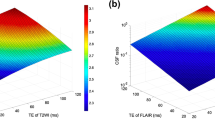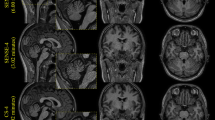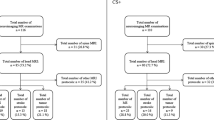Abstract
Objective
The Fluid And White matter Suppression (FLAWS) MRI sequence provides multiple T1-weighted contrasts of the brain in a single acquisition. However, the FLAWS acquisition time is approximately 8 min with a standard GRAPPA 3 acceleration factor at 3 T. This study aims at reducing the FLAWS acquisition time by providing a new sequence optimization based on a Cartesian phyllotaxis k-space undersampling and a compressed sensing (CS) reconstruction. This study also aims at showing that T1 mapping can be performed with FLAWS at 3 T.
Materials and methods
The CS FLAWS parameters were determined using a method based on a profit function maximization under constraints. The FLAWS optimization and T1 mapping were assessed with in-silico, in-vitro and in-vivo (10 healthy volunteers) experiments conducted at 3 T.
Results
In-silico, in-vitro and in-vivo experiments showed that the proposed CS FLAWS optimization allows the acquisition time of a 1 mm-isotropic full-brain scan to be reduced from \(8 \mathrm{mins}\) to \(6 \mathrm{mins}\) without decreasing image quality. In addition, these experiments demonstrate that T1 mapping can be performed with FLAWS at 3 T.
Discussion
The results obtained in this study suggest that the recent advances in FLAWS imaging allow to perform multiple T1-weighted contrast imaging and T1 mapping in a single \(6 \mathrm{mins}\) sequence acquisition.





Similar content being viewed by others
Data availability statement
The participants of this study did not give written consent for their data to be shared publicly, so due to the sensitive nature of the research supporting data is not available.
References
Mugler JP, Brookeman JR (1990) Three-dimensional magnetization-prepared rapid gradient-echo imaging (3D MP RAGE). Magn Reson Med 15:152–157
Sudhyadhom A, Haq IU, Foote KD, Okun MS, Bova FJ (2009) A high resolution and high contrast MRI for differentiation of subcortical structures for DBS targeting: the fast gray matter acquisition T1 inversion recovery (FGATIR). Neuroimage 47:T44–T52
Marques JP, Kober T, Krueger G, van der Zwaag W, Van de Moortele P-F, Gruetter R (2010) MP2RAGE, a self bias-field corrected sequence for improved segmentation and T1-mapping at high field. Neuroimage 49:1271–1281
Van de Moortele P-F, Auerbach EJ, Olman C, Yacoub E, Uğurbil K, Moeller S (2009) T1 weighted brain images at 7 Tesla unbiased for proton density, T2⁎ contrast and RF coil receive B1 sensitivity with simultaneous vessel visualization. Neuroimage 46:432–446
Tanner M, Gambarota G, Kober T, Krueger G, Erritzoe D, Marques JP, Newbould R (2012) Fluid and white matter suppression with the MP2RAGE sequence. J Magn Reson Imaging 35:1063–1070
Chen X, Qian T, Kober T, Zhang G, Ren Z, Yu T, Piao Y, Chen N, Li K (2018) Gray-matter-specific MR imaging improves the detection of epileptogenic zones in focal cortical dysplasia: a new sequence called fluid and white matter suppression (FLAWS). Neuroimage Clin 20:388–397
Li X, Yu T, Ren Z, Wang X, Yan J, Chen X, Yan X, Wang W, Xing Y, Zhang X, Zhang H, Loh HH, Zhang G, Yang X (2021) Localization of the epileptogenic zone by multimodal neuroimaging and high-frequency oscillation. Front Hum Neurosci. https://doi.org/10.3389/fnhum.2021.677840
Sun K, Yu T, Yang D, Ren Z, Qiao L, Ni D, Wang X, Zhao Y, Chen X, Xiang J, Chen N, Gao R, Yang K, Lin Y, Kober T, Zhang G (2021) Fluid and white matter suppression imaging and voxel-based morphometric analysis in conventional magnetic resonance imaging-negative epilepsy. Front Neurol 12:651592
Emorine T, Megdiche I, Brugieres P, Creange A, Kober T, Massire A, Bapst B (2022) 3-dimensional fluid and white matter suppression magnetic resonance imaging sequence accelerated with compressed sensing improves multiple sclerosis cervical spinal cord lesion detection compared with standard 2-dimensional imaging. Invest Radiol. https://doi.org/10.1097/RLI.0000000000000874
Massire A, Seiler C, Troalen T, Girard OM, Lehmann P, Brun G, Bartoli A, Audoin B, Bartolomei F, Pelletier J, Callot V, Kober T, Ranjeva JP, Guye M (2021) T1-based synthetic magnetic resonance contrasts improve multiple sclerosis and focal epilepsy imaging at 7 T. Invest Radiol 56:127–133
Boutet A, Loh A, Chow CT, Taha A, Elias GJB, Neudorfer C, Germann J, Paff M, Zrinzo L, Fasano A, Kalia SK, Steele CJ, Mikulis D, Kucharczyk W, Lozano AM (2021) A literature review of magnetic resonance imaging sequence advancements in visualizing functional neurosurgery targets. J Neurosurg 1:1–14
Bannier E, Gambarota G, Ferre J-C, Kober T, Nica A, Chabardes S, Haegelen C (2018) FLAWS imaging improves depiction of the thalamic subregions for DBS planning in epileptic patients. The International Society for Magnetic Resonance in Medicine (ISMRM)
Wang Y, Wang Y, Zhang Z, Xiong Y, Zhang Q, Yuan C, Guo H (2018) Segmentation of gray matter, white matter, and CSF with fluid and white matter suppression using MP2RAGE. J Magn Reson Imaging 48:1540–1550
Beaumont J, Gambarota G, Saint-Jalmes H, Acosta O, Ferré J, Raniga P, Fripp J (2020) High-resolution multi-T1 –weighted contrast and T 1 mapping with low sensitivity using the fluid and white matter suppression (FLAWS) sequence at 7T. Magn Reson Med 85:1364–1378
Beaumont J, Saint-Jalmes H, Acosta O, Kober T, Tanner M, Ferré J-C, Salvado O, Fripp J, Gambarota G (2019) High Contrast T1-Weighted MRI with fluid and white matter suppression using MP2RAGE. IEEE International Symposium on Biomedical Imaging. Venice, Italy, pp 701–704
Beaumont J, Saint-Jalmes H, Acosta O, Kober T, Tanner M, Ferré JC, Salvado O, Fripp J, Gambarota G (2019) Multi T1-weighted contrast MRI with fluid and white matter suppression at 1.5 T. Magn Reson Imaging 63:217–225
Muller J, la Rosa F, Beaumont J, Tsagkas C, Rahmanzadeh R, Weigel M, Bach Cuadra M, Gambarota G, Granziera C (2022) Fluid and white matter suppression: new sensitive 3T magnetic resonance imaging contrasts for cortical lesion detection in multiple sclerosis. Invest Radiol. https://doi.org/10.1097/RLI.0000000000000877
Mussard E, Hilbert T, Forman C, Meuli R, Thiran JP, Kober T (2020) Accelerated MP2RAGE imaging using Cartesian phyllotaxis readout and compressed sensing reconstruction. Magn Reson Med 84:1881–1894
Griswold MA, Jakob PM, Heidemann RM, Nittka M, Jellus V, Wang J, Kiefer B, Haase A (2002) Generalized autocalibrating partially parallel acquisitions (GRAPPA). Magn Reson Med 47:1202–1210
Piccini D, Littmann A, Nielles-Vallespin S, Zenge MO (2011) Spiral phyllotaxis: the natural way to construct a 3D radial trajectory in MRI. Magn Reson Med 66:1049–1056
Lustig M, Donoho D, Pauly JM (2007) Sparse MRI: The application of compressed sensing for rapid MR imaging. Magn Reson Med 58:1182–1195
Hollingsworth KG, Jones DE, Aribisala BS, Thelwall PE, Taylor R, Newton JL, Blamire AM (2009) Globus pallidus magnetization transfer ratio, T1 and T2 in primary biliary cirrhosis: relationship with disease stage and age. J Magn Reson Imaging 29:780–784
Chung S, Kim D, Breton E, Axel L (2010) Rapid B1+ mapping using a preconditioning RF pulse with TurboFLASH readout. Magn Reson Med 64:439–446
Marques JP, Gruetter R (2013) New developments and applications of the MP2RAGE sequence - focusing the contrast and high spatial resolution R1 mapping. PLoS ONE 8:e69294
Wright PJ, Mougin OE, Totman JJ, Peters AM, Brookes MJ, Coxon R, Morris PE, Clemence M, Francis ST, Bowtell RW, Gowland PA (2008) Water proton T 1 measurements in brain tissue at 7, 3, and 1.5T using IR-EPI, IR-TSE, and MPRAGE: results and optimization. Magn Reson Mater Phy 21:121–130
Commowick O, Wiest-Daessle N, Prima S (2012) Block-matching strategies for rigid registration of multimodal medical images. In: Priya D (ed) 2012 9th IEEE international symposium on biomedical imaging (ISBI). IEEE, UK, pp 700–703
Ourselin S, Roche A, Prima S, Ayache N (2000) Block matching: a general framework to improve robustness of rigid registration of medical images. Springer, Berlin, Heidelberg, pp 557–566
Acknowledgements
We thank the “Region Bretagne” (France), which partially funded the current study. We are also grateful to the team at the Herston Imaging Research Facility for their generous scan time allowances and technical support in acquiring the data presented here.
Author information
Authors and Affiliations
Contributions
JB: study conception and design, acquisition of data, analysis and interpretation of data, drafting of manuscript, critical revision. JF: study conception and design, acquisition of data, critical revision. PR: acquisition of data, critical revision. OA: study conception and design, critical revision. JCF: analysis and interpretation of data, critical revision. KLMM: acquisition of data, critical revision. JT: acquisition of data, critical revision. TK: study conception and design, analysis and interpretation of data, critical revision. GG: study conception and design, analysis and interpretation of data, drafting of the manuscript, critical revision.
Corresponding author
Ethics declarations
Conflict of interest
Tobias Kober is fully employed at Siemens Healthcare, Switzerland. None of the other authors has any conflict of interest to disclose.
Additional information
Publisher's Note
Springer Nature remains neutral with regard to jurisdictional claims in published maps and institutional affiliations.
Supplementary Information
Below is the link to the electronic supplementary material.
Rights and permissions
Springer Nature or its licensor (e.g. a society or other partner) holds exclusive rights to this article under a publishing agreement with the author(s) or other rightsholder(s); author self-archiving of the accepted manuscript version of this article is solely governed by the terms of such publishing agreement and applicable law.
About this article
Cite this article
Beaumont, J., Fripp, J., Raniga, P. et al. Multi T1-weighted contrast imaging and T1 mapping with compressed sensing FLAWS at 3 T. Magn Reson Mater Phy 36, 823–836 (2023). https://doi.org/10.1007/s10334-023-01071-5
Received:
Revised:
Accepted:
Published:
Issue Date:
DOI: https://doi.org/10.1007/s10334-023-01071-5




